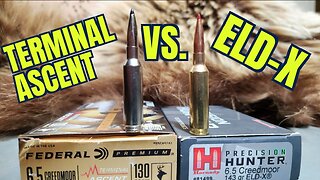Premium Only Content

How to Choose the Best Dog Food?
To buy "Facts about Animals" a coffee: https://www.buymeacoffee.com/AnimalsandFacts
To become our contributor: https://www.buymeacoffee.com/AnimalsandFacts/wishlist Today we will try to find the answer to the question How to Choose the Best Dog Food?
In an ideal world, all dog food would be created equal. Instead, dog owners are presented with an overwhelming array of options, all claiming to be the best dog food on the market.
Wading through these choices to find a dog food brand that is healthy, affordable, and appealing to your pet is often frustrating. We’ve compiled expert advice to help you narrow down your options.
What Makes a Dog Food “Good”?
Most people feed their dog's dry kibble or canned wet food.
These processed foods might not appeal to us, but they contain all the nutrients dogs need to stay healthy.
Quality commercial dog foods are highly regulated and have undergone rigorous testing by veterinary specialists.
So what exactly is in these dog foods?
Dogs, unlike cats, are not strict carnivores.
While meat makes up most of their diet, domestic dogs can also derive nutrients from grains, fruits, and vegetables.
These non-meat foods are not simply fillers but can be a valuable source of essential vitamins, minerals, and fiber.
Good dog food will contain meat, vegetables, grains, and fruits.
The best dog foods contain high-quality versions of these ingredients that are appropriate for your dog’s digestive system.
Dog Food Nutrition
The best dog food for your canine companion should meet his nutritional needs.
While most commercial dog food brands are specially formulated with at least the minimum nutritional requirements for dogs, it is important to remember that not every dog has exactly the same nutritional needs.
Dogs require a wide range of nutrients in different quantities over the course of their lives.
The nutritional needs of a puppy are different from an adult dog, which is why it is a good idea to feed a puppy formula or an “all life stages” food to your young dog.
If you are unsure about the differences in nutritional requirements between puppies and adults, the Merck Veterinary Manual lists the recommended nutrients for dogs, along with the recommended amount by weight and age.
Large breed dogs and puppies have different nutritional requirements than small breed dogs and puppies.
Dog Food Myths and Misinformation
There are plenty of dog food myths and misinformation about dog nutrition on the Internet.
You can sort through it by following one simple rule: check your sources.
Many well-meaning individuals make claims about dog nutrition without backing them up with scientific evidence.
As you do research, check to see if the information is supported by a credible source, like a veterinarian, canine nutritionist, or scientific study.
It never hurts to be skeptical, either. If it sounds too good to be true, it probably is.
Many people have questions about grain-inclusive or grain-free dog food, pea-free dog food, or dog foods containing animal byproducts. If your dog has been diagnosed with a food allergy caused by grains, you may choose a grain-free diet under the guidance of your veterinarian.
For most dogs, grains are actually a source of wholesome nutrients.
Quality animal byproducts are also nutritious.
These include organ meats and entrails, which often contain more nutrients than the muscle meat consumed by humans.
Regulated byproducts do not include hooves, hair, floor sweepings, intestinal contents, or manure.
As with any pet-related inquiry, feel free to discuss your concerns about your dog’s food with your veterinarian.
How to Read a Dog Food Label.
One way to decipher good dog food from bad dog food is to read the label.
This is easier said than done, as labels can be hard to read, both due to the small print and just plain awkwardness of handling big bags of dog food in the store!
But labels can also be misleading, as the Merck Veterinary Manual explains.
Dog food labels are required by the Food and Drug Administration (FDA) to tell you eight key pieces of information, and individual states may also have their own labeling requirements:
Product Name.
The product name alone tells you a lot about what’s inside the can or bag.
The term “beef” means that beef must make up at least 70 percent of the entire product.
The terms “beef dinner,” “beef entrée,” or “beef platter,” on the other hand, only require that beef makes up at least 10 percent of the entire product.
“With beef” only requires that 3 percent of the total product be beef, and “beef flavor” simply implies that there is enough beef in the product to flavor it (less than 3 percent).
The same holds true for other named ingredients like “chicken.”
-
 1:31:49
1:31:49
Kim Iversen
5 hours agoCIA Fingerprints All Over JFK’s Assassination: Dirty Secrets & Shocking Israeli Connections??
75.3K76 -
 2:03:50
2:03:50
vivafrei
8 hours agoElon CONFIRMS Biden Played Politics with Astronauts; JFK Files Dud? Trump Attacks Poilievre & MORE!
148K123 -
 LIVE
LIVE
Dr Disrespect
8 hours ago🔴LIVE - DR DISRESPECT - WARZONE - 10 WINS IN A ROW EVENT
1,893 watching -
 44:20
44:20
Candace Show Podcast
4 hours agoRyan Reynolds Wants to COME OUT… Of The Lawsuit | Candace Ep 163
86.1K57 -

LFA TV
1 day agoEurope: ‘To Avoid War, We Must Get Ready for War’ | TRUMPET DAILY 3.19.25 7PM
12K5 -
 LIVE
LIVE
2 MIKES LIVE
3 hours ago2 MIKES LIVE #194 News Breakdown Wednesday!
156 watching -
 10:05
10:05
Tundra Tactical
3 hours agoPam Bondi MISSES 2A Report Deadline!
5.91K4 -
 21:52
21:52
AlaskanBallistics
17 hours ago $0.05 earnedFederal Terminal Ascent vs. Hornady ELD-X 6.5 Creedmoor
4.01K2 -
 1:42:16
1:42:16
The Officer Tatum
5 hours agoLIVE Tesla Vandalism is the NEW J6 + MORE Officer Tatum Show EP 81
65.1K24 -
 2:09:34
2:09:34
Darkhorse Podcast
7 hours agoDeportations, Doxxing, Measles Vaccine: 268th Evolutionary Lens with Bret Weinstein & Heather Heying
51.6K47